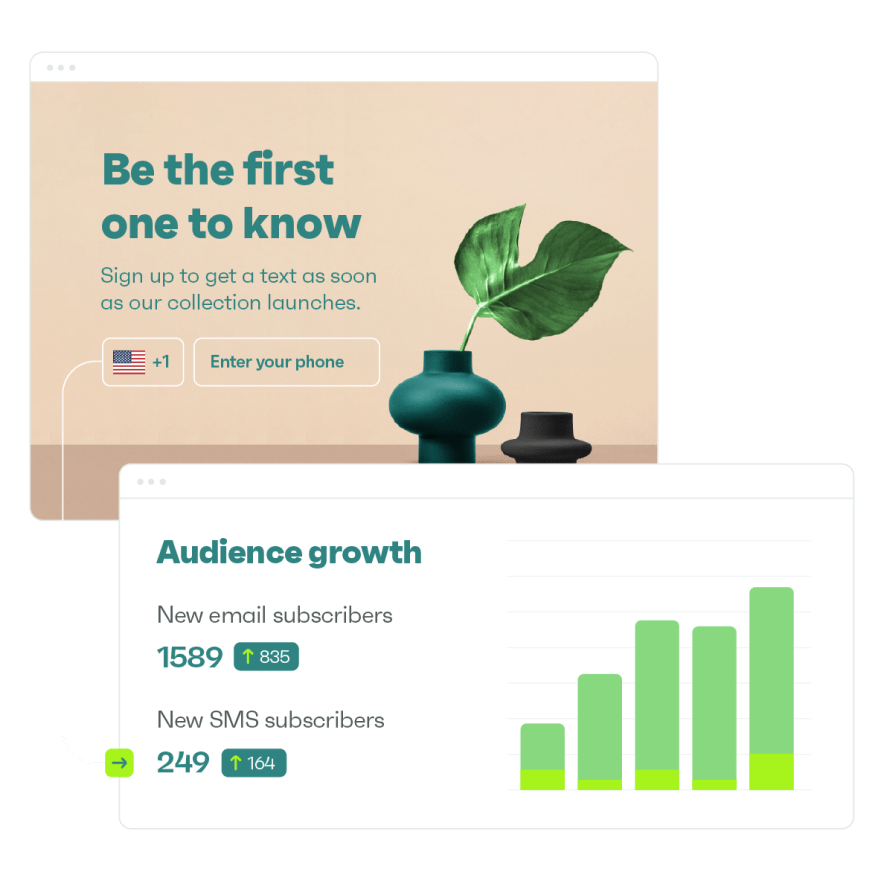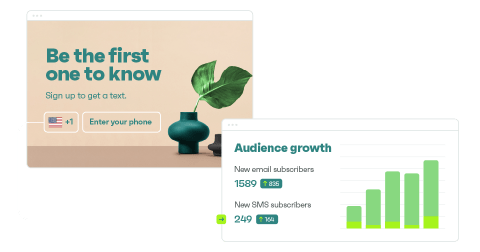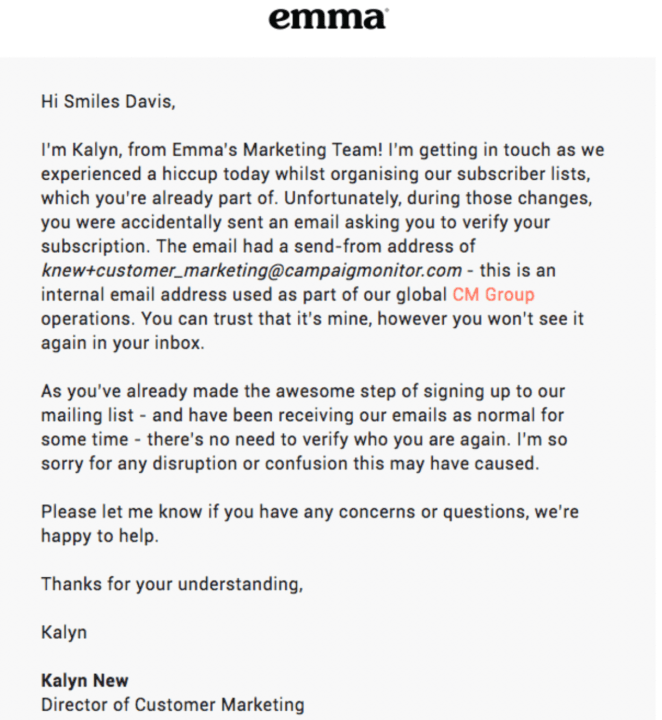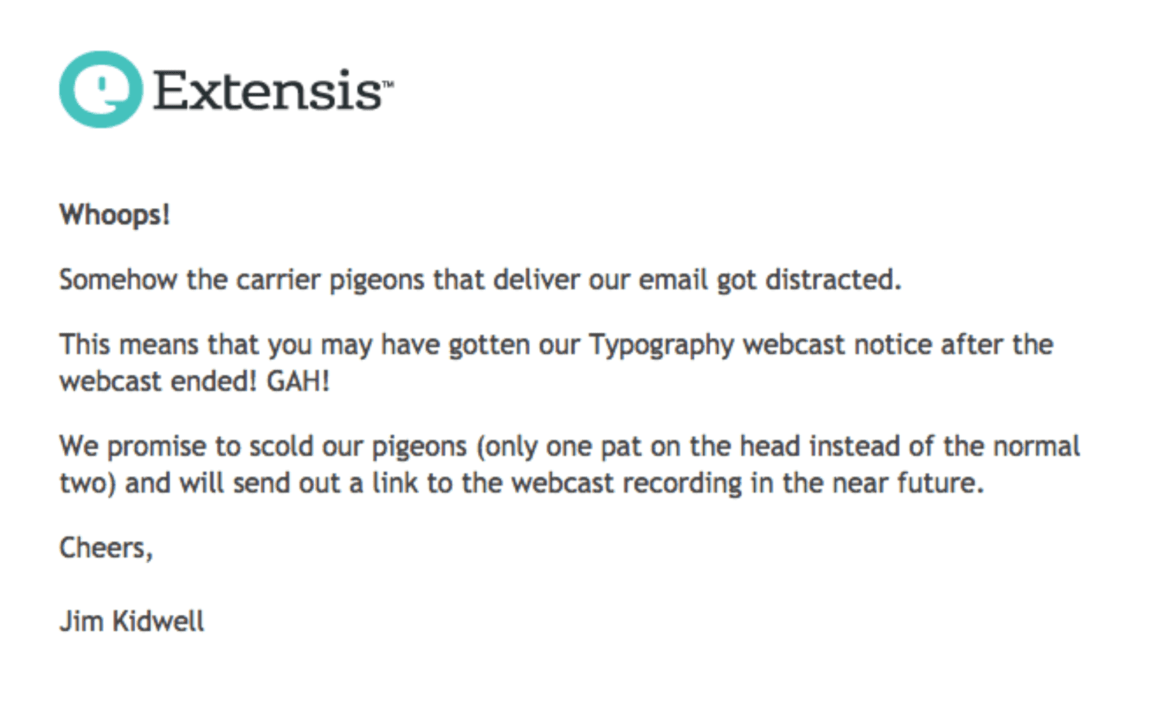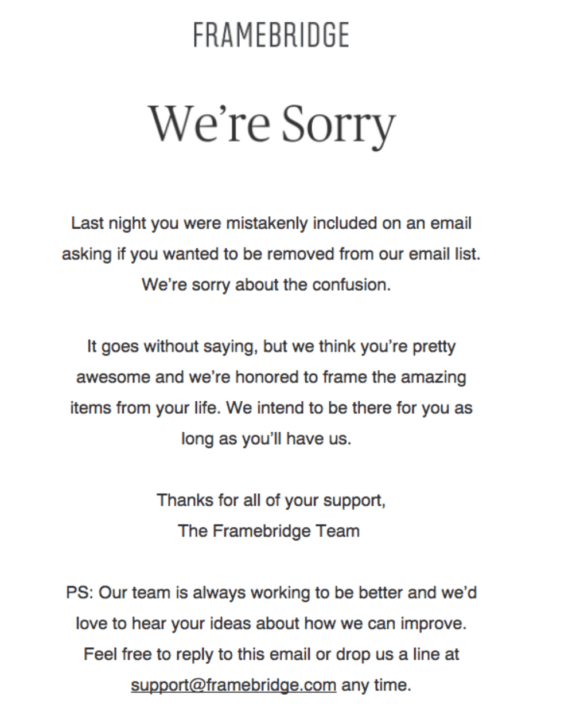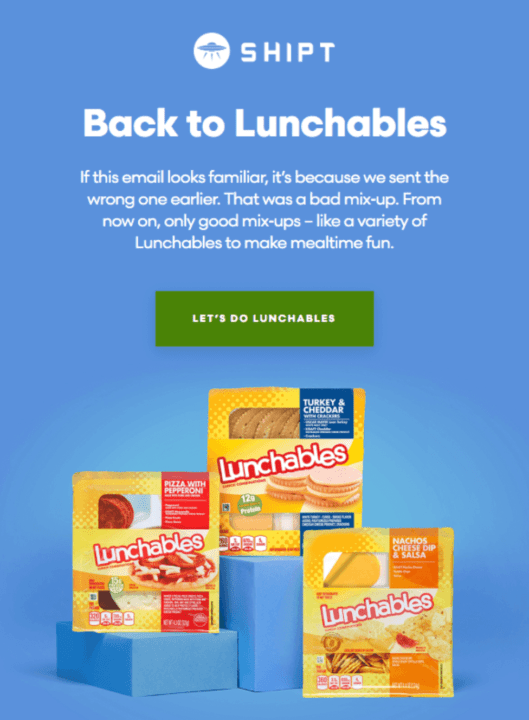Drive sales on autopilot with ecommerce-focused features
See FeaturesHow to turn email mistakes into customer loyalty opportunities [+ examples]
Benjamin Franklin once said that nothing is certain except death and taxes. Well, we can add mistakes to that list as well, because we’re all guaranteed to make them at some point.
While we’d all prefer it if they didn’t happen, the most important thing is how you handle them.
Unless the mistake is catastrophic, people are generally understanding, caring less about the mistake itself and more about your response.
So instead of burying your head in the sand, wishing you could turn the clocks back, or refusing to address the problem until a lengthy investigation has been completed, view it as an opportunity.
This is the time to show your human side: quickly acknowledge the mistake and reassure customers that you’ve got it under control.
Handled correctly, a mistake can help to increase customer loyalty. We say this from experience, because we recently made a mistake ourselves.
Omnisend’s mistake
During testing, an email was accidentally sent to all of our customers that warned them of a problem with their account.
This type of message could cause panic for business owners:
Are our subscribers getting our emails?
Is this going to cost me in lost revenue?
How do I fix this?
Our priority was to contact our customers as soon as possible to confirm that their accounts were fine, and the email had been sent by mistake.
We sent this response within 20 minutes of the original email going out, putting ourselves in our customers’ position and making sure they knew they could relax—they didn’t need to do anything, nothing was wrong, and it was entirely our fault:
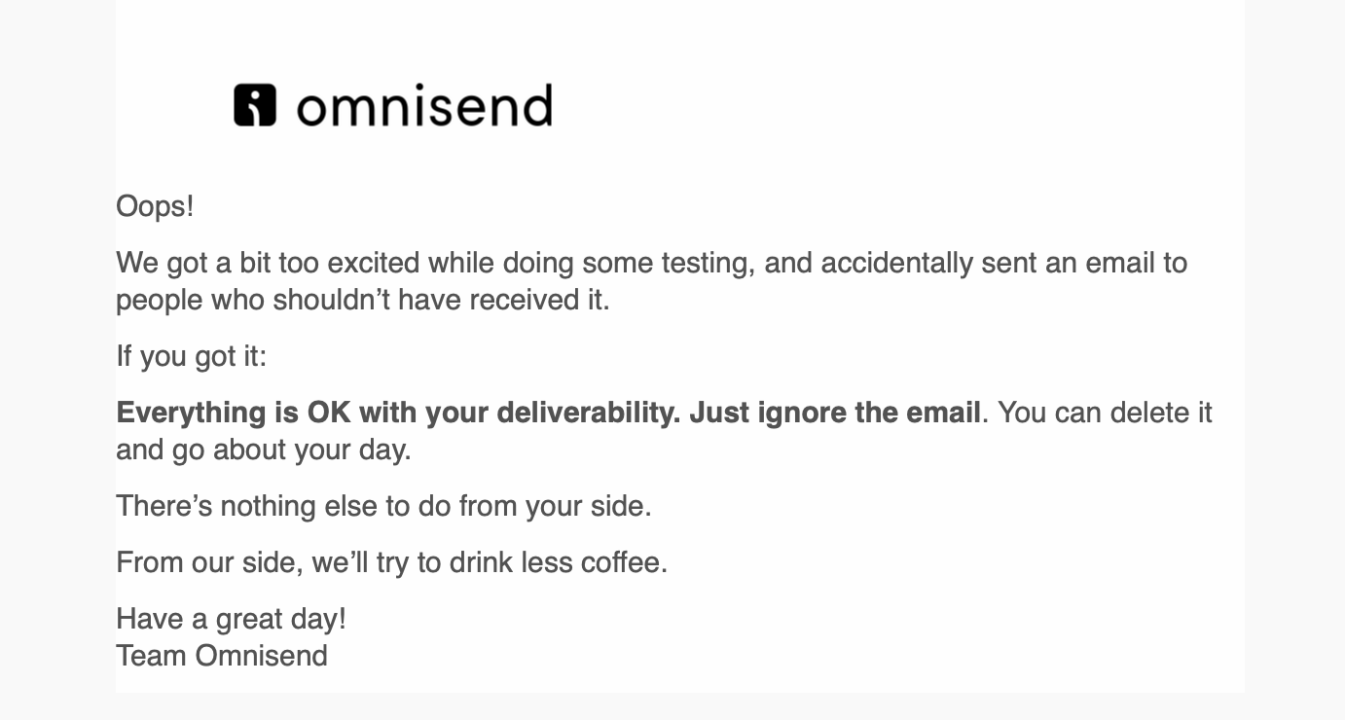
Five steps to turn a mistake into an opportunity
When a mistake happens, you’ll need to respond swiftly if you want to avoid it getting out of control. Here are the five steps you should take:
Understand the scope of the problem
Before sending a response, you need to know what went wrong and how it impacted your customers.
This will influence your response. You can be more humorous if there’s no consequence, but not if you’ve just caused someone to lose millions in revenue.
Your response also needs to be conclusive and accurate: if it causes more confusion or is wrong, it’s like throwing petrol onto a bonfire. So while it’s important to respond quickly, it’s also important to not be hasty.
If the situation isn’t clear and you’re investigating, admit that. People appreciate honesty and if you reassure customers that it’s resolved when you’re still not sure what went wrong, you’re likely just making the situation worse.
That said, if it’s not possible to give a clear answer straight away, try to give a sensible timeframe for when you’ll have answers. Your customers will accept that a mistake was made, but they won’t accept feeling like you’re not adequately handling the situation.
Respond quickly
Sending an email that causes panic is like putting a match to paper: the longer it’s left unchecked, the bigger the fire will grow. Or you can douse it in water to put it out immediately.
It’s the same with your email mistake. The longer you leave it, the more customers will panic. They might start contacting your support team—potentially leading to longer wait times because of the demand, causing further frustration.
Or they might turn to social media, informing additional people about your mistake.
They may decide that the mistake and poor response is sufficient reason to close their account and switch to a competitor instead.
If you want to stop the fire from spreading, you have to put your customers first. This means acknowledging what they want: to do their job and not have undue stress. To feel confident that they’re using the right company for their business, and to trust that you can correct any mistake that happens.
With all that in mind, put their mind at ease by responding quickly and concisely so there’s minimal disruption to their day.
Keep it light
The response is about your customers. They want reassurance and to get on with their work—not to read your lengthy explanation.
The opportunity is for you to be human, relatable, and empathetic. In a concise manner, explain what happened and if the customer needs to do anything. Unless the mistake was huge, you don’t need to go into great detail about what happened and all the steps you’ve taken to fix it.
A simple acknowledgement that you made a mistake and will take steps to ensure it won’t happen again is sufficient. And of course, offer any support that may be needed to help your customers get back on track.
For example, you can see that we acknowledged our mistake by saying “we got a bit too excited while doing some testing, and accidentally sent an email to people who shouldn’t have received it.” This is short and to the point.
If your mistake has consequences for your customers, such as them not being able to send emails, a drop in sales, or something else, clearly offer support to help rectify the situation. For example, if multiple people will have the same consequence, you could record a tutorial video that shows them what to do. Alternatively, if it’s possible you could offer to correct the problem for them, or have a free call to answer questions.
As we’ll see a bit further on, you can also invite your customers to share their ideas, feedback, and questions with you—this way, you know you’re giving exactly what they need.
Strengthen customer relationships
This is an opportunity to put your money where your mouth is. It’s one thing to say you’re customer-centric, but when a mistake happens and customers actually need you, do you demonstrate your values? Here’s your chance.
The worst thing you can do is to pretend the mistake didn’t happen, or try to place the blame elsewhere. Instead, if you take responsibility for your mistake, apologize, and are transparent with your customers, you might be amazed at the positive response.
Always remember that people buy from people, and this is an opportunity to be human. To say “sorry, we messed up” and for your customers to say “hey don’t worry, we all make mistakes.”
When Omnisend made our mistake, we received multiple messages from customers telling us it was okay and that they loved our response—some even sent us gifts!
Learn from the mistake
All of the above are fundamental steps, but it’s also important to keep mistakes to a minimum. People are understanding and often forgiving, but if you’re causing problems every other week, you’re inviting your customers to leave you for a competitor.
Make sure you find out what caused the mistake to ensure it doesn’t happen again. Sometimes it’s a genuine human error, but sometimes it’s a process failure or a tech oversight that the team wasn’t aware of. In these cases, implementing new processes can reduce the risk of a repeat incident.
Best of all, learning from your mistakes strengthens your business and improves the customer experience—which, of course, you can communicate to your customers.
Get a head start on your comms
If a mistake happened in your business today, how quickly could you contact your customers?
- Do you already have processes in place?
- Are there bottlenecks in your business, such as the need for a PR person to create or approve any customer communications?
- How many people or teams would need to be involved in a response?
While it’s not possible to predict the future, it’s a good use of time to create some processes in this regard. This can include prompts you could use in a response, with modifications made as needed, and deciding which people would be needed (and contingencies if those people aren’t available on the day).
Once these processes have been created, commit them to a document that’s available to the appropriate people. This way, if a mistake is made, you’ll be able to react swiftly.
4 real-life examples of company mistakes
There’s no specific formula for writing a good response email to your customers. Some are very short, others are longer. The main considerations are to be empathetic, consistent with your usual brand voice, and get to the point quickly.
This first example, from emma, is on the longer side. Yet despite having more than two paragraphs of text, it still feels punchy and direct. Most importantly, it briefly explains what the error was, why it happened, reassures the customer that they can trust it was a real email and not spam, and confirms they don’t need to do anything:
The following example from Extensis is extremely concise and incorporates humor to reassure subscribers that the mistake won’t happen again:
This example from Framebridge recaps what the mistake was, apologizes for confusion, and thanks customers for their support. It also ends by asking for feedback on how they can improve, which is a thoughtful inclusion:
Last but not least, Shipt combines its apology with fun product promotion. It clearly acknowledges the mistake of sending the wrong email previously, then cleverly links “good mix-ups” with the Lunchable products:
Wrap up
Mistakes happen. Everyone makes them, and the true test for businesses isn’t whether they can avoid ever making any but how they respond to them.
Customers are typically happy to forgive you, if they trust that it was a genuine mistake and something that won’t happen repeatedly. But don’t take that loyalty for granted: when a mistake happens, it’s important that you react quickly, responsibly, and empathetically.
By using the five action points shared in this article, you’ll be able to turn email mistakes into customer loyalty opportunities.
quick links
related features
No fluff, no spam, no corporate filler. Just a friendly letter, twice a month.
